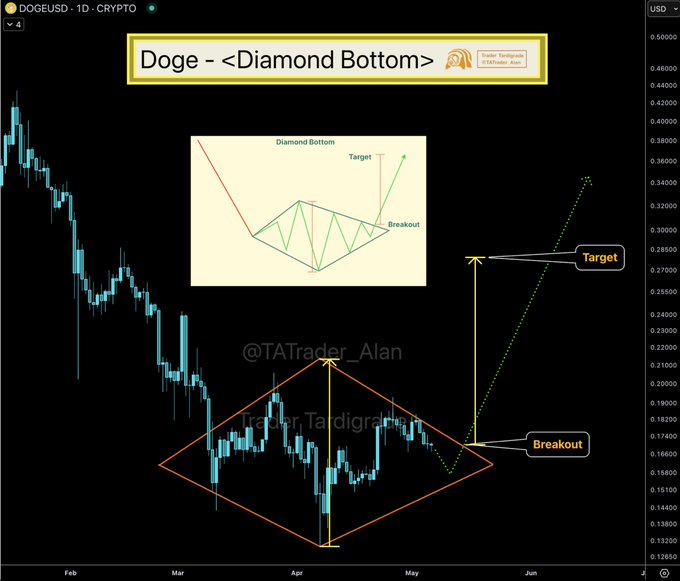
Dogecoin price is poised for a potential breakout after forming a rare diamond bottom pattern on the daily chart. According to technical analyst Trader Tardigrade, the DOGE price structure shows a bullish reversal setup that could send the DOGE price over 105% higher to $0.35.
This bullish forecast comes despite Dogecoin price falling 1.5% in the last day and 3% in the last week. However, in the last 30 days, bulls have had the upper hand with DOGE price soaring 15%.
Dogecoin Price Diamond Bottom Pattern Hints at Rally
Trader Tardigrade has identified a diamond bottom pattern on the daily DOGE/USD chart. This pattern typically signals a bullish reversal when it forms after a sustained downtrend. According to the chart, the breakout level is around $0.165–$0.17.
This projection places the DOGE price target between $0.255 and $0.35. The chart also shows a dotted green arrow pointing toward the $0.35 level, suggesting a more optimistic scenario for a breakout extension.
Ali Charts, another crypto analyst, noted that Dogecoin price is testing support at $0.167. He stated, “Holding this level could spark a rebound toward $0.175 and potentially $0.183.” Both analysts agree that maintaining the $0.165–$0.167 zone is critical for bullish momentum to continue.
The Price Momentum Oscillator (PMO) also confirms a bullish crossover, which may support further gains if buying volume increases. These indicators support the case for a possible rally if current support holds.
DOGE ETF Approval May Accelerate Dogecoin Price
DOGE ETF speculation is rising in the market as several asset managers have applied for approval. These include Bitwise, 21Shares, Grayscale, and REX Shares. They are awaiting clearance from the U.S. Securities and Exchange Commission (SEC) to launch Dogecoin ETFs. According to Polymarket, DOGE ETF approval odds have risen by 25%, with analysts giving a 63% chance that it may be approved by the end of 2025.
According to a CoinGape report, if Dogecoin receives 30% to 50% of Bitcoin ETF inflows, the price could rise to between $0.34 and $0.50. This scenario is based on an estimated $12 to $20 billion entering DOGE markets. The forecast also projects that DOGE’s total market capitalization could more than double under this model.
ETF approval, in the same vein, would likely pull more institutional investors to its side hence increasing the demand even further. This potential flow of capital corresponds to the $0.35 level depicted in the technical indication. According to analysts, the approval news can be considered as a potential trigger for the price rally and take DOGE past the $0.255 barrier.
Holding Behavior Shows Investor Confidence
New data from IntoTheBlock suggests that investor sentiment for Dogecoin is improving. The average holding time of transacted DOGE coins has increased by over 526% in the last 90 days. This behavior is similar to the trend seen before Dogecoin’s 2021 bull run.

In just the past seven days, holding time has risen by four months. This shift from short-term speculation to long-term holding reduces sell pressure. It also suggests that investors expect the DOGE price to rise soon. If this trend continues, it could support a more stable base for further growth.
Long-term holders now dominate the transaction volume, which often happens before strong upward price moves. Reduced market supply, combined with growing demand, is a positive signal.
The post Expert Predicts Dogecoin Price to Rally 105% As DOGE ETF Odds Rise By 25% appeared first on CoinGape.









 Grayscale’s Cardano
Grayscale’s Cardano 
